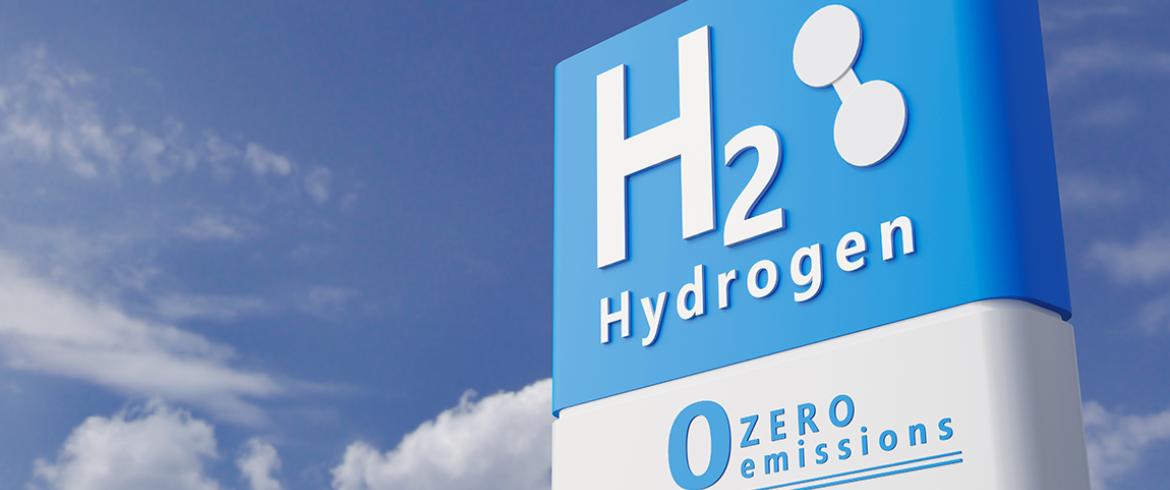
3D illustration by EZPS for Adobe Stock
A potent “green” energy source, hydrogen promises clean power but demands not only new science but a workforce with new, high-tech skills.
With a U.S. Department of Energy (DOE) grant, researchers at the FAMU-FSU College of Engineering are searching for materials to enable reliable, long-term hydrogen energy infrastructure.
The college received approximately $1.7 of a $2.25 million award from the DOE through Florida A&M University (FAMU) for the project, which includes preparing the workforce for new energy science. Principal Investigator Brandon Krick, an associate professor in mechanical engineering, and a team of researchers from the joint college are partnering with North Carolina A&T State University and the Department of Energy Ames National Laboratory at Iowa State University on the study.

“Hydrogen is one of the clean technologies the U.S. and other countries are pursuing. The DOE has something they call the ‘Energy Earthshots’ to address the climate crisis,” Krick said. “They are trying to put together resources and people to enable clean energy technologies in the battle against global warming and depletion of non-renewable resources.”
The first Energy Earthshot is the hydrogen shot, which aims to provide abundant, affordable and reliable access to hydrogen by reducing the cost of clean hydrogen by 80%. Unlike fossil fuels, when hydrogen is burned in an engine or fuel cell, the exhaust is mainly water vapor, without hydrocarbons, carbon monoxide or carbon dioxide. One of the challenges of hydrogen is that its molecules are small and can make their way through traditional materials like steel. When the fuel gets into the metal, it causes damage. Known as hydrogen embrittlement, it renders metals less ductile.
“We are trying to develop hydrogen-tolerant materials that can survive the extreme environment associated with hydrogen use, storage and production— temperatures ranging from below -423°F to greater than 2200°F,” Krick said.
Krick specializes in materials tribology, focusing on friction and materials wear in extreme environments. The Ames National Lab is known for designing new alloy material systems and determining how and why hydrogen damages those materials. The researchers at NC A&T are experts in molecular dynamics and will be doing simulations to visualize what is happening at the atomic scale.
“We have a broad team, five team members here, six at Ames, and another at NC A&T,” Krick said. “On top of that we are actively recruiting many students to study how hydrogen affects the structural and tribological properties of materials.”
“We plan to build a one-of-a-kind system here at the college where we characterize material properties in the hydrogen environment,” Krick said. “Our project has two goals: to design and test next-generation alloys for high-temperature applications and then develop advanced coatings for use in a hydrogen environment.”
Building our next-generation workforce
This type of cutting-edge research to create and scale new hydrogen infrastructure materials will need a skilled energy science workforce. The DOE recognizes this need, so a big part of the project involves training and research opportunities for the next-generation sciences workforce.
The HI-POWER Basic Energy Sciences RENEW program that funds the research also seeks to create a pipeline of talented engineers. One goal is to create a large cohort of students working together to gain momentum in materials research.
“The aim is to establish lasting networks between partner minority-serving institutions, DOE national labs and leading industry partners, where students and early-career professionals can thrive and pursue productive careers in energy research and technology development,” said Nicolas Argibay, a researcher with the DOE Ames National Laboratory
“We plan to have training for undergraduate students doing research with us,” Krick said. “Over the summer, they will have the opportunity to conduct research at the Ames Lab. At the same time, we will recruit several students to come to FAMU over the summer to do research here.”
According to Argibay, the DOE is pursuing ambitious technical and workforce development goals, including undergraduate-through-junior-faculty opportunities to spend time in the DOE facilities. This will provide opportunities for research both at Ames and elsewhere working with state-of-the-art equipment for materials and process characterization.
“We recognize that to retain its leadership in science and technology innovation, America must increase the number of overlooked STEM graduates at all levels,” Carl Moore, an associate professor in mechanical engineering from the FAMU-FSU College of Engineering, said.
“HI-POWER promises a strong push in this direction through the focused recruitment of graduate students and undergraduate research assistants from previously disadvantaged groups. And we’re wasting no time. This summer, our inaugural research program enrollment is 75% African-American.”
“At the end of the day, it’s the students who drive things,” Krick said. “To push research and technology, we need to fill our classrooms with strong students. The way the team works, it’s a web of interactivity and we want as much cross-pollination as possible. Students are the most important part of this program and it’s going to give many opportunities for so many to get real experience in research.”
The research team includes Brandon Krick, Carl Moore, Lance Cooley, William Oates and Fumitake Kametani from the FAMU-FSU College of Engineering; J. David Schall, from North Carolina A&T State University and Nicolas Argibay, Duane Johnson, Ryan Ott, Prashant Singh, Iver Anderson and Jun Cui, from the Ames National Laboratory.
The DOE-Office of Basic Energy Science-Reaching a New Energy Sciences Workforce (BES-RENEW) funds the research and supports the energy roadmap, identifying hydrogen as an energy source to reach net zero carbon emissions by 2050.
RELATED ARTICLES
Five FAMU-FSU Engineering students land prestigious NSF Fellowships
Two in One: Researchers Develop Polymer that Can Be Adapted to High and Low Temperature Extremes
